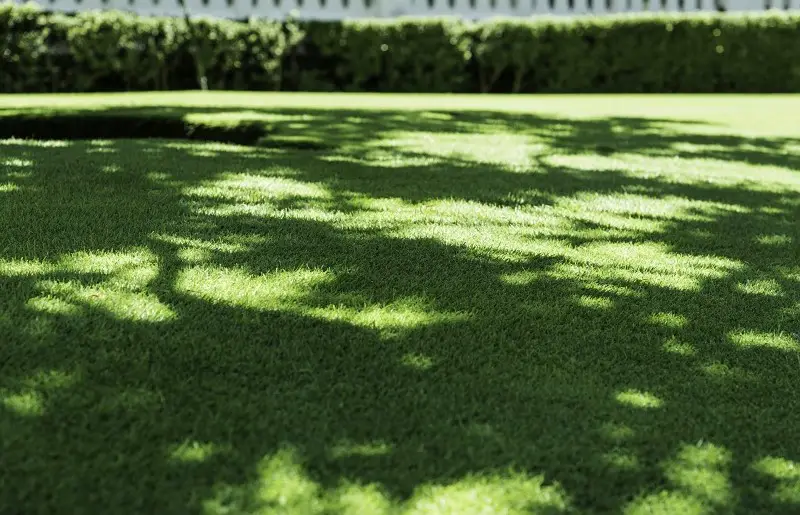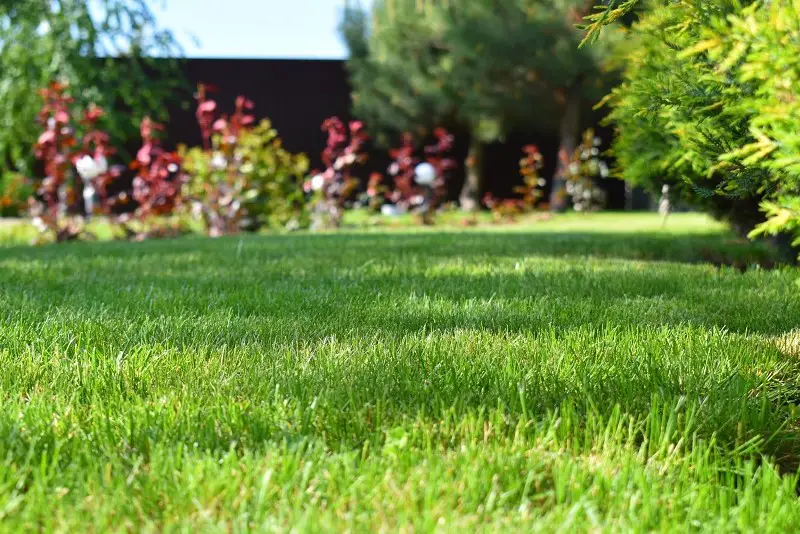When decorating a lawn, gardeners often use several types of grass. Buffalo grass and Bermuda grass are in particular demand. These herbs are not only beautiful but also practical. A detailed comparison of Buffalo grass vs Bermuda grass we describe in this article.

Comparative characteristics of Buffalo grass and Bermuda grass
When comparing Buffalo grass vs Bermuda grass, first you need to study the basic parameters. Young Buffalo grass has a soft texture and a delicate blue-green hue.
This type of lawn grass is durable and can easily tolerate shade.
It fits perfectly into all styles of landscape design, while not changing the appearance of the site itself.
Bermuda grass is shorter in stature and has a more rigid structure. It can spread throughout the area. To avoid this, it is recommended to install special barriers. You also need to follow a precise schedule for mowing the Bermuda grass lawn.
What is the difference between Bermuda grass and buffalo grass? More about it, you can find out later.

Appearance
Buffalo grass has a delicate texture. It is soft to the touch and silky. This is the best option if you are looking for tall warm season grass for your lawn. After all, on average, the length of the grass is from 2 inches.
If you plant the warm season grasses in the shade, the height is somewhat higher, about 3-4 inches. This figure exceeds Bermuda grass by 4 times.
Bermuda grass is different in that it resembles massive above-ground roots. Several stalks of Bermuda grass are formed, running vertically. After that, they interlock with the rest of the grass, forming a dense and beautiful lawn. It has a rich green hue and broad stems with a rough texture.
It is important to note that small hairs are on the leaves. Therefore, the surface is slightly terry and does not differ in a glossy sheen.

The use of Bermuda grass and Buffalo grass
Buffalo grass is ideal for areas where there is little traffic. The site should be slightly in the shade so that the grass can easily recover after cutting.
The grass prefers to grow in regions with a warm climate. Despite this, it can easily withstand frost. It needs regular hydration, as well as a top dressing. Thanks to this, the greenery is preserved, even if the weather is dry outside.
Bermuda grass needs more abundant watering and more nutrients. Designed for lawns with medium traffic. It is often preferred by gardeners living in regions with heavy rainfall. After all, they differ in that stagnant water often appears.

Soil type and acidity
Buffalo grass prefers to grow in poor, sandy soils. At the same time, if silt or loamy soil prevails in your area, sowing grass is not prohibited. The climate should be slightly dry. If the area accumulates water that does not absorb into the soil, there may be problems with the lawn.
Buffalo grass, with high soil moisture levels, may experience diseases and mold. The optimal indicators of the acid-base balance of the soil should be in the range of 6 to 7.5. This is a very wide range when compared to other popular warm region herbs.
Buffalo grass can handle alkaline soil with ease. If the acidity is high, only then does the grass begin to discolor.
Bermuda grass should be grown in the pH range of 6 to 7. It also tolerates high levels of acidity more easily. Problems can arise if the number of alkali increases.
The soil should be nutritious, with good drainage. In the warm season, grass can grow on most types of soil. The only exception is heavy clay. It is important to constantly saturate the soil with organic matter. This allows the grass to be saturated with them for proper growth.

How much water is required
You need to water every week the Buffalo grass lawns if you want to grow them well. The depth of wetting should be 0.5 inches. The plant is quite resistant to low humidity, so additional irrigation is not required. This makes Buffalo grass an optimal and versatile option for all lawns.
Bermuda grass requires about 1-1.5 inches of water. However, these indicators are required every week. This type of lawn grass is not drought tolerant and can absorb and release more water than is required at high air temperatures.

Temperature, lighting, and shade requirements
Buffalo grass prefers to grow in well-lit areas. If it is impossible to plant it in an open area, it is shade tolerance.
However, during the warm season, grasses need to get at least 2 hours of full sun every day. The more full sun the plant receives, the more intense the blue-green pigment it has.
If there is more shadow, it takes longer to cut. For example, if sunlight shines on the grass for 4-6 hours a day, the grass is at least 3 inches tall.
Once temperatures begin to drop and the first frosts appear, Buffalo grass goes dormant.
In the spring, as soon as the air temperature rises, the grass begins to turn green. This is observed if the average air temperature is 45° F.
Bermuda grass should only be sown in well-lit areas. In the shade, it is ugly. The pasture grass can survive extremely low air temperatures.
However, if the winter was long and frosty, the plant takes a long time to recover.
As soon as the air temperature is observed within 55° F, the plant stops growing. At a temperature of 32° F, the grass goes into a dormant state so as not to freeze and not be damaged.

The durability of different lawns
Buffalo grass is not very durable. The surface is quite soft and smooth. However, it is not very resistant to damage.
It should be noted that the recovery is also quite slow. Adult bushes are more resistant to mechanical damage and disease.
Many people wonder which type of grass is best for the lawn, and what is the toughest grass? Bermuda grass has a longer lifespan compared to Buffalo grass. Although it cannot boast of strength it is called the toughest grass. Herb recovery is pretty low.
To compensate for this minus, the rapid growth of grass is provided. Therefore, dead areas quickly fill with new greens.

Maintenance needs
Buffalo grass needs minimal maintenance. But Bermuda grass needs to be looked after with special awe and attention.
Buffalo grass does not need frequent and abundant watering. It is not necessary to fertilize and cut the grass very often. Despite this, the grass is beautiful and healthy.
Buffalo grass is short growing. Therefore, a haircut should be carried out in the warm season with an interval of 1 month. Grass grows even if there is no constant fertilization.
At the same time, it is important to monitor the amount of nitrogen applied.
On average, 2 pounds of nitrogen is required per 1,000 sq. feet. This amount is for 1 year.
Bermuda grass needs regular and thorough maintenance. You need to mow it often. Much more nitrogen is also required. In summer, grass growth rates are quite high.
That is why it is advisable to carry out a haircut at an interval of 1-2 weeks. The exact timing depends on the species.
Bermuda grass needs constant feeding. In the summer, at least 4 pounds of nitrogen is applied per 1,000 sq. feet. Only in this way the plant is distinguished by excellent health and beauty.

Vulnerability to weeds
Buffalo grass is more susceptible to weeds than Bermuda grass. It is constantly overgrown with grassy and broad-leaved weeds. This category includes dandelion and rosemary.
This type of grass is slow to take root, which is why weeds and other types of grass constantly fill the site. The deterioration of the appearance of the grass is observed if there is a large amount of precipitation. Especially if their volume is 30 inches.
Grass can lose its beauty if it is constantly fed with nutrients. Since fertilizers contribute to the growth of weed crops.
Bermuda grass is rapidly spread and establishment. It has a rather aggressive effect on weed crops, in particular, on northern lawns. The root system is quite large, so it quickly spreads the grass around the site.
If there are empty areas in the yard, Bermuda grass fills them quickly. That is why excellent competitiveness distinguishes this culture.
If you choose to create a Buffalo grass lawn, maintenance is minimal. In this case, the site is distinguished by a unique shade and texture. It is different from other lawns that the neighbors have. However, it is not suitable for active heavy foot traffic.
Bermuda grass is appropriate if the site has a fairly active cross-country ability. For example, you have children and pets who love to play on the lawn. The lawn is undersized, while its appearance is more “traditional”.

FAQ
When comparing buffalo grass vs Bermuda grass, a lot of questions arise. Detailed answers to the most popular of them we describe below.
- What grass is better than Bermuda, is Augustine grass or Zoysia grass suitable for lawns? An excellent alternative to Bermuda grass is St. Augustine grass. Especially if the area has poor lighting, Bermuda with Augustine grass is the best choice. Bermuda and Zoysia grass needs constant sunlight. This is the only way to ensure optimal growth. St. Augustine grass is unpretentious. Therefore, Augustine grass is the best and more versatile option.
- Is Buffalo grass good for cattle? Buffalo grass is ideal for cattle grazing areas. Especially if you need to graze in the winter. This is because animals should consume short stems and graze until bare patches form.
- Which is better, Bermuda or fescue? Bermuda grass has better drought tolerance than tall fescue. At the same time, it stays green longer, even if it is not watered in normal weather. Tall fescue can easily withstand drought without going dormant. The main thing is that the air temperature does not rise more than 85 °F.
Results
As you can see, Buffalo grass and Bermuda grass are quite different. The difference is not only in appearance and features of care. There is also resistance to mechanical damage. Their only similarity is that they are ideal for lawn decoration. You should try to plant such lawn grass on the site to decorate the territory and give it more comfort.
- Why Are There Still No Tomatoes in My Tomato Plants? Let’s Fix the Issue! - July 13, 2023
- Water Propagation White Stuff on Roots: Everything You Should Know! - July 11, 2023
- String of Dolphins Drying Up: Solved! - July 11, 2023

